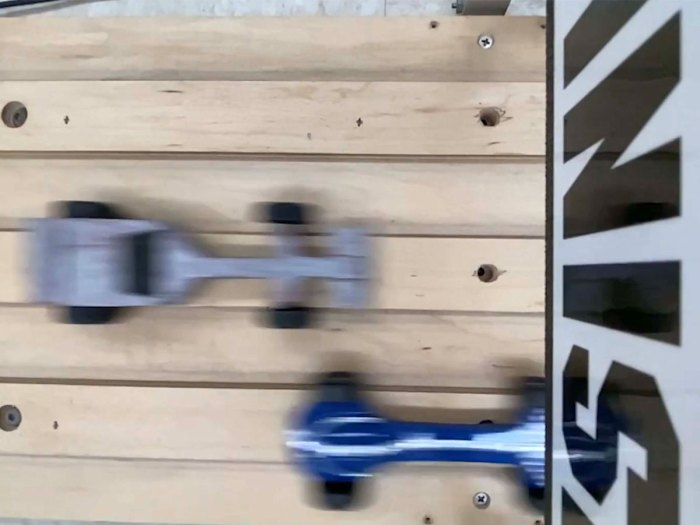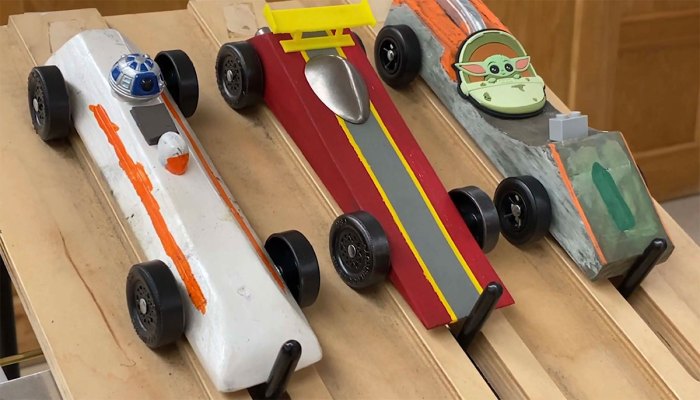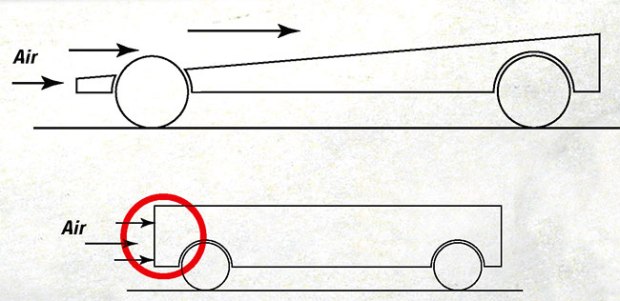How to Make a Fast Pinewood Derby Car

Packs nationwide are gearing up for their annual Pinewood Derby race, and the one thing everyone wants to know: How do I make a fast Pinewood Derby car?
There are a variety of ways to make your Pinewood Derby car go faster. Explore the following tips to optimize your car’s performance and gain a competitive edge in an upcoming race.
BASIC BUILDING GUIDELINES TO GET YOU STARTED
The possibilities are endless when it comes to creating a fast Pinewood Derby car. Before you begin, consider the following general guidelines:
Avoid Pointed Noses: A pointed nose will make it difficult for your car to rest on the pin at the starting gate. It may also cause your Pinewood Derby car to get bumped around when the pin drops, and it can create problems for electronic timing systems at the finish line.
Weight Distribution: Leave ample wood in the rear of the Pinewood Derby car so you can place additional weight there. Concentrate the majority of the weight in the rear for optimal performance.
Maximum Weight: Aim for the maximum allowable weight allowed by your pack’s rules, typically limited to 5 ounces in most races. If your car falls short of this weight, strategically add coins or other weights to meet the requirement.
Clarity in Orientation: Clearly distinguish the front and back of your Pinewood Derby car. In many races, the race officials — not you — will actually place each car on the track. Sometimes the officials put cars on the track backward because they can’t tell which end is which.
Aerodynamic Design: Select a design that facilitates smooth airflow over and around the car body. Pinewood Derby cars with aerodynamic profiles go faster.
Need design ideas? See photo galleries of hundreds of Pinewood Derby cars.

10 STEPS FOR DESIGNING AND BUILDING A FAST PINEWOOD DERBY CAR
You don’t have to strive for the fastest Pinewood Derby car to have fun competing in your Pinewood Derby. But if you and a helpful adult are willing to put in the extra time and effort, these speed tips are for you.
1. Bake the Block: Start your Pinewood Derby car project by baking the wood block at 250 degrees for two hours. This removes moisture and lightens the block, allowing you to place more weight at the rear of the car where you actually want it.

2. Crafting the Design: Outline your Pinewood Derby car on paper, cut it out, and affix it to the wood block.
Remember, a rectangular car is not an aerodynamic design. The most basic aerodynamic design is a simple wedge. If you don’t have time to design a complex car, a wedge will work just fine.
Download a Pinewood Derby car template PDF to help you create your design.
3. Rough Cut the Design: Use a coping saw or enlist the help of a responsible adult with a power tool to cut out the rough shape of your Pinewood Derby car.
4. Shape Your Car: Smooth edges and shape your car using sandpaper. An adult can assist with a rotary tool or other shaping tools.
5. Sand and Paint Creatively: Reduce friction by smoothing the car’s surface and paint an awesome design to make it look great.
How to paint your Pinewood Derby car to give it a shiny finish.
6. Axles and Wheels Alignment: Make sure they are aligned perfectly straight. You can test the alignment of your axles by pushing your car across a smooth floor or table. It should roll smoothly in a straight line.
- Consider a Three-Wheeler: Raise one wheel about 1/16 inch higher so it never actually touches the track. Less friction = more speed. Rules vary from pack to pack, so make sure to check your pack’s Pinewood Derby rules to make sure three wheelers are allowed in your race.
- Extend the Wheelbase: Maximize the distance between front and rear wheels. Again, make sure this is allowed in your race.
Inspect axles closely to make sure they are smooth without ridges or burrs. You can use sandpaper to remove any imperfections.
Learn about polishing Pinewood Derby axles and wheels to reduce friction.
7. Secure Axles with Glue: Glue the axles firmly in their holes to ensure that they stay perfectly placed, but make sure you don’t get glue on your wheels.
8. Strategic Weight Addition: Remember to make your Pinewood Derby car as heavy as the rules allow. In general, it’s best to place weight to the rear of your car because a heavier rear increases speed.
Learn scientific Pinewood Derby speed tips from a former NASA engineer.
9. Use Graphite: Add graphite or another dry lubricant to reduce friction. The less friction between the body and wheel, the better.
10. Have fun! And finally, remember the most important rule of a Pinewood Derby is that it’s supposed to be fun. While you should always strive to do your best, don’t get caught up in winning or having the fastest car. Just enjoy the ride.
Adapted from the book “Pinewood Derby Speed Secrets,” DK Publishing, $12.95 softcover.
The best thing about derby cars is keeping them to show your kids some day. Winning only means having to go somewhere else and spend another night standing around a racetrack.
How do you make a pine wood derby car fast
nice advice.
just about to do a derby race
I learned last year when the boys’ cars were too light that pennies work as last minute weights.(It looked cute too since their themes on the cars were pirate ships.)
The reason the “three wheel trick” works (assuming your car still goes straight etc) is that one less wheel is using up potential energy being converted to rotational energy, which leaves more potential energy for kinetic (speed) energy.
The three wheel thing is not allowed in our pack. All wheels have to touch. Also, there are rules about how far apart the wheel bases can be. Make sure you check your pack’s rules.
The only kids that win are the ones who have a parent that spends endless hours engineering the car just right. There are no rules or governance involved with the process. It’s basically teaching kids how to cheat by having a parent do all the work. I refuse so my kid loses every year. Boy scouts is outdated and horribly organized.
I agree. I give limited help, for my child is too young to wield power tools and saws in 2nd grad.
I will only cut the design. The boys do the rest of the work. I feel there needs to be a rule about best in show being limited to “work done by boys only, except design cut”
C,mon guy. Do you really expect a tiger to know how to smooth axels and use power drills?
I totally agree with three year champ
that is so not true!
YEP
How did they get the shark fin too be that tall?Isn’t there a height rule?
Additional wood can be used to add height. Most districts don’t have a height regulation, just width for the track and weight
Buckethead,
You may be right about height restrictions if your Pack or District uses electronic timing devices. It is always a good idea to ask first about size limits before adding anything that might increase the overall size of the basic block in a pinewood derby kit.
I’m a eagle scout and i used the body style of a nascar and put the weights on the bottom of the car and I’ve won first over 6 years know
I had better success putting the weight in the front, kinda did the same as the 3 wheeler, it took so much weight off the rear that the friction wasn’t as much of a factor. Also see if you can get a tire dealer to donate stick on wheel weights. They come in 1/4 ounce segments, Would love to cut the thickness of the front wheels down, but I was warned ….